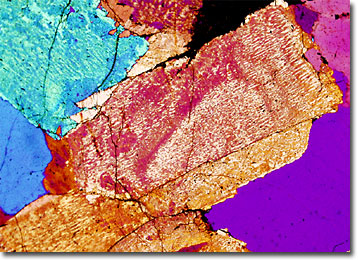Polarized Light Microscopy Digital Image Gallery
Alkalic Granite
The word granite derives from the Latin granum, which means “a grain,” a reference to the grained structure of the visibly crystalline rock. A popular building material for thousands of years, granite is believed to be the most prevalent plutonic rock in the Earth’s crust.

Granites form when magmas slowly cool deep within the Earth at great pressures. This process sometimes results in tabular bodies, such as sills and dikes, but the rock more often occurs in irregularly shaped masses of various sizes. Indeed, some granite masses may be extensive, reaching thousands of square kilometers in area and comprising significant parts of mountain ranges, while others are significantly smaller. The color of granite is also variable, depending greatly upon the rock’s constituent minerals and the ratios in which they occur.
Though primarily composed of quartz and feldspars, granite also frequently contains small amounts of hornblende, micas, and other minerals. Moreover, the proportion of plagioclase to alkali feldspar may differ in granite samples, which is often utilized as the starting point for granite classifications. Alkalic, or alkali, granites, for instance, are those in which the alkali feldspar content significantly exceeds the plagioclase. These types of rocks characteristically contain pyroxenes and sodic-amphiboles. In the United States, samples of alkalic granite can be found in New England, but they also occur notably in Norway and Nigeria.
